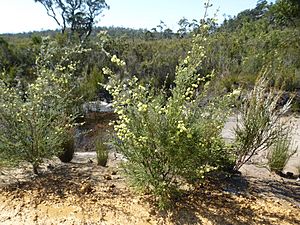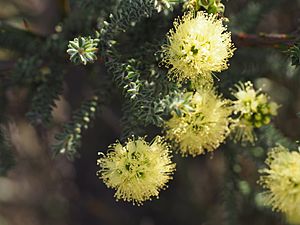Kunzea ericifolia facts for kids
Kunzea ericifolia, also known as spearwood, native tree, or yellow kunzea, is a special plant found only in Western Australia. The Noongar people, who are the traditional owners of the land, call it kitja boorn, poorndil, or condil. It's a tall, woody shrub that stays green all year round. Spearwood has soft green leaves and round clusters of yellow flowers that bloom in spring.
Quick facts for kids Spearwood |
|
|---|---|
 |
|
| Kunzea ericifolia growing near Lake Seppings | |
| Scientific classification | |
| Genus: |
Kunzea
|
| Species: |
ericifolia
|
Contents
What Spearwood Looks Like
Spearwood is a woody shrub that grows upright. It often has many stems and can reach up to 6 metres (about 20 feet) tall, but it's usually around 2 metres (6.5 feet) high. Its long, thin stems branch out from the bottom, forming many flexible, narrow branches. The plant has a soft, light green leafy top.
Its leaves are simple and thin, like lines. They grow to about 10 millimetres (0.4 inches) long and 1 millimetre (0.04 inches) wide.
Flowers and Fruit
Spearwood flowers bloom in spring, from July to December. The small, round flowers are about 10 millimetres (0.4 inches) across. They are usually yellow, cream, or white and have a pleasant smell. These round flowers grow in clusters at the ends of the branches.
After the flowers, small, single-celled fruits appear. Each fruit holds many tiny seeds. When the fruit is ripe, the seeds are released.
Bark
The bark of the Spearwood plant is rough and grey. It's fibrous, meaning it looks like it's made of many threads. The bark often peels off the stem in layers.
Naming Spearwood
The Spearwood plant was first officially described in 1812 by a scientist named James Edward Smith. He gave it the name Metrosideros ericifolia. This name came from a plant sample collected by Archibald Menzies in 1791.
Later, in 1840, Gustav Heynhold gave the plant its current scientific name, Kunzea ericifolia. The second part of the name, ericifolia, means "leaves like Erica." This is because the leaves of Spearwood look similar to plants in the Erica family.
Where Spearwood Grows
Kunzea ericifolia is found in the southwest part of Western Australia. You can find it as far north as Gingin and as far east as Bremer Bay on the south coast. The largest groups of Spearwood plants grow around Albany.
Many Spearwood plants grow along the coastline. A group of them can also be found in the Fitzgerald River National Park. These plants often grow in areas where wetlands meet drier land.
The suburb of Spearwood in Perth was named after this plant. In 1897, when James Morrison divided the land to create the Spearwood Garden Estate, it was the first time the name was used.
How Spearwood Lives
Spearwood grows best in sandy soil that drains water well. It can also grow in peaty soils, quartzite, and grey sand. It likes moist conditions and often grows along the edges of rivers, lakes, and swamps that are wet during certain seasons. You might also find it growing among rocks in more open, higher places.
This plant needs good drainage and a sunny or slightly shaded spot. It is well-suited to a Mediterranean climate, which has warm, dry summers and mild, wet winters. It can handle a moderate frost and will also grow in more humid conditions.
Bushfires and Recovery
Spearwood plants can be destroyed by bushfires. However, new seedlings can quickly grow back and fill the area after a fire. This is why you often see groups of Spearwood plants that are all about the same age and size.
When Spearwood plants grow close together, they form thick groups. They also produce a lot of fallen leaves. This creates a special environment where many different types of orchids can grow, including some rare ones. These thickets also provide shelter for animals, like the New Holland honeyeater, which builds its nests among the branches.
Uses of Spearwood
Growing Spearwood in Gardens
Spearwood has been grown as a garden plant for many years, though it's not as common as some other Kunzea species. It's easy to grow from seeds or cuttings. Many people believe it has more potential as a garden plant than is currently recognized.
Traditional Uses
As its name suggests, "spearwood" was often used by Indigenous people to make spears for hunting animals.
Other Uses
Scientists have found that Spearwood contains a natural insecticide called ericfolione. This substance can be extracted from the plant. The strong stems of Spearwood are also used in commercial gardens to support climbing plants. They are also used for fencing and to build craypots, which are traps for catching crayfish. Because of these uses, people sometimes illegally harvest the plant, which can harm its populations.
Early European settlers used Spearwood to make a native tea. They found it refreshing and also used it as a health tonic. More recently, it has been used to make poles for bean plants in market gardens and to construct craypots.
Images for kids





